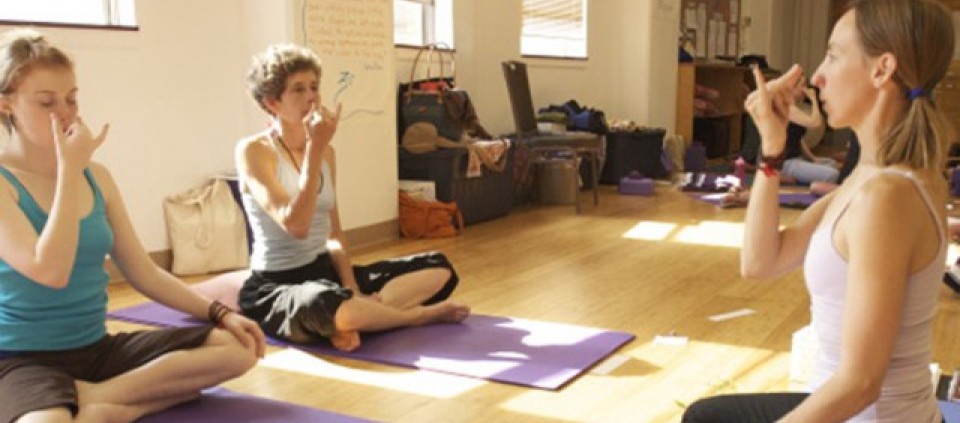Reinvigorating a Pranayama Home Practice

Need a refresher course in establishing—or reestablishing—a pranayama routine at home? Here are some practical approaches for incorporating these self-nurturing, transformative techniques into your daily life.
Begin by creating a sacred space for your pranayama practice. Choose a private location free from interruption and distraction, with good air circulation. If possible, find a spot void of electronics. In good weather, consider an outdoor location (this is my favorite and most frequent choice for my personal pranayama practice). Make it welcoming: beautify your space with bits of inspiration (fresh flowers, mala beads, statues, photos of loved ones or teachers, sentimental objects, favorite quotes). Have fresh water, tissues, and a journal handy.
Choose a time to practice daily. Pranayama is best done in the early morning and on an empty stomach, but gentle techniques such as Dirgha, Ujjayi, and Nadi Shodhana can be practiced just about any time of day. Consistency is more important than duration, so choose the most viable time to delve into your home practice.
Prepare a steady, comfortable seat. Sitting on a cushion or folded blanket is ideal to support level hips, an erect spine, and a relaxed belly. If the knees are tender or the hips are tight, sitting on a block or straddling a bolster are wonderful options. Even sitting on the edge of a chair with the feet grounded and the knees over the ankles can provide comfort for tender spots or long sessions.
Begin with a body scan to check how you’re feeling—physically, energetically, mentally, and emotionally—and consciously relax the major tension holders in the body (the forehead, eyes, jaw, shoulders, belly, palms of the hands, and soles of the feet). Take a few deep breaths to ground your attention in the present moment and transition from the activities of the day into a space of simplicity, serenity, and mindful awareness.
Set an intention. Reading an inspiring quote or choosing an internal focal point for transformation can provide profound healing in every session.
It’s often best to pick your favorite breathing techniques and do them daily. But for a frequent pranayama sequence, explore the following:
- Dirgha (Three-Part Breath): three to five minutes. Fill the belly, rib cage, and collarbones with a smooth, wave-like breath to anchor the attention in the present. When you establish a comfortable rhythm, layer on Ujjayi (Ocean-Sounding Breath). Create the meditative ocean-like sound in the throat to further calm and quiet the fluctuations of the mind. Keep the breath fluid and rhythmic; avoid straining or forcing the breath.
- Pause and feel the harmonizing effects of Dirgha and Ujjayi. Scan for new sensations.
- Kapalabhati (Skull-Polishing Breath): 30 seconds to one minute. Engage a steady stream of strong exhales and passive inhales, through the nose initiated by the pumping of the belly during the exhalations. Don’t force the breath; rather, focus on the rejuvenating power of the belly pumping. Keep the breath even and rhythmic. (Contraindications: Don’t practice Kapalabhati if you have uncontrolled high blood pressure, glaucoma, hernia, or abdominal discomfort; have had surgery recently; are pregnant; or are on the first few days of menses.)
- Pause and feel the effects of Kapalabhati. Scan for sensations of aliveness (vibration, heat, tingling, lightness, expansion, softness, enhanced awareness).
- Nadi Shodhana (Alternate-Nostril Breath/Channel-Purifying Breath): three to five minutes. Using the right hand in Vishnu mudra (folding the middle and index fingers into the palm and keeping the ring and little fingers and thumb straight), close off the right nostril gently with the thumb and inhale through the left nostril. Switch, exhaling through the right nostril. Inhale through the right nostril, switch, and exhale through the left nostril. Continue this sequence. Keep the breath smooth, long, and gentle to balance the hemispheres of the brain, soothe the nervous system, and quiet the mind.
- Pause and feel the physical, energetic, mental, and emotional effects of Nadi Shodhana.
- Take several minutes of silent meditation to bask in the raised prana and integrate the fruits of your practice.
As your home pranayama practice develops, it can be helpful to reach out for inspiration from experienced teachers and peers. Remember, just a few minutes of concentrated breathing each day can provide abundant gifts.
Larissa Hall Carlson, E-RYT 500, MA, 20-year Kripalu faculy and former Dean of the Kripalu School of Ayurveda, guides retreats, directs trainings, and provides Ayurvedic consultations across the country.
Full Bio and Programs